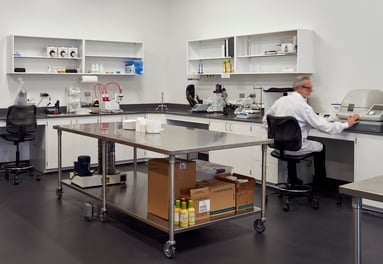How laboratory design and space requirements are evolving

In a conversation with Nicole Raliegh on the Pharmaphorum podcast, Bobby Savarese, Senior Principal, Unispace Life Sciences shares his thoughts on trends like sustainability and technology influencing the life sciences sector, and space design.
What are blue chip pharma companies focusing on?
In our Global Life Sciences Benchmarking report, Forefront, we surveyed and interviewed over 180 life sciences leaders to learn about practices and trends influencing in the industry. What we found was engineering and research teams have readapted their primary goals based on what happened during and post-pandemic. Among the key areas of focus was sustainability.
How are companies meeting their sustainability initiatives?
56% of our survey respondents indicated having sustainability goals and implementation guidelines. The result is a pathway target of total carbon neutrality. This primarily will be achieved through three key areas:
- Reducing carbon footprints
- Conservation of water
- Designing green buildings
How can the next generation laboratory set the pace for future innovation?
FutureLab considers the critical technologies needed in a laboratory. This includes:
- Lab information management systems
- Digital twin technology
- Applied AI technology
- Bio safety and cyber safety
Using quantum computers, we can unify these technologies and accelerate the R&D project life cycle and enable faster reliance recognition for new drug approval.
How does this impact laboratory design?
From our experience creating spaces to house quantum computers, we’ve found it’s critical to implement the right facility requirements like heating and cooling systems, clean room space, and specific flooring. Architectural features like ceiling height also need to adapt to host the quantum computers.
How does this optimize lab space requirements?
One of the key goals of FutureLab is reducing space per R&D specialist by 2 sqm. We can achieve this through:
- Optimizing flexible space allocation
- Integrating technologies within an open space environment to create collaborative collision courses
- Creating regulated concierge service delivery
How have labs evolved?
The post-pandemic era has encouraged us and life sciences companies to look for ways to improve processes and drug discovery while maintaining the status quo. FutureLab will enable companies to reduce their square footage but more importantly be more efficient and socially engaged. By using technologies to get into a faster reliance recognition, we’re creating a harmony of bringing different groups of people together to accelerate drug approvals for many of the diseases out there.
Want to learn more about FutureLabs? Get in touch with us.
|
Connect with Bobby on LinkedIn |



